Hai bisogno di rimuovere il ricamo ma temi di danneggiare il tessuto?
All'inizio può sembrare complicato, ma con gli strumenti giusti e passaggi attenti, puoi rimuovere i punti in tutta sicurezza senza lasciare buchi o segni.
Che si tratti di un errore di progettazione o di un vecchio ricamo che non desideri più, seguire una procedura passo passo ti aiuterà a proteggere il tuo tessuto e a mantenerlo fresco.

In questa guida, ti guideremo attraverso metodi dettagliati ma semplici per la rimozione del ricamo senza causare danni, in modo da poter gestire facilmente qualsiasi incidente di ricamo!
Semplici passaggi per rimuovere il ricamo senza danneggiare il tessuto
Puoi rimuovere il ricamo a macchina?
sì, rimuovere il ricamo a macchina è possibile e può essere eseguito con gli strumenti giusti e tecniche attente. Whether it’;è un disegno del ricamo non ti piace più o è un errore che deve essere corretto, puoi toglierlo senza rovinare il tessuto.
Tuttavia, richiede pazienza, soprattutto per punti piccoli o disegni dettagliati. Alcuni tessuti, come la pelle, velluto, o materiali sottili, potrebbe mostrare segni di ago o danni dopo la rimozione.
In questi casi, è possibile rimuovere il ricamo senza problemi?
Non sempre, ma con attenzione e il metodo giusto, puoi ridurre il rischio di danni.
Strumenti essenziali per rimuovere il ricamo
Per rimuovere con successo il ricamo senza danneggiare il tessuto, è importante avere gli strumenti giusti. Questi strumenti renderanno il processo più fluido e sicuro, assicurandoti di poter togliere i punti senza danneggiare il materiale.
Ecco un elenco delle opzioni dello strumento di rimozione del ricamo di cui avrai bisogno:

Taglia cuciture: Questo piccolo punto ricamo lo strumento di rimozione è progettato per tagliare i punti con precisione. È ideale per rimuovere con cura i ricami senza tagliare il tessuto sottostante.
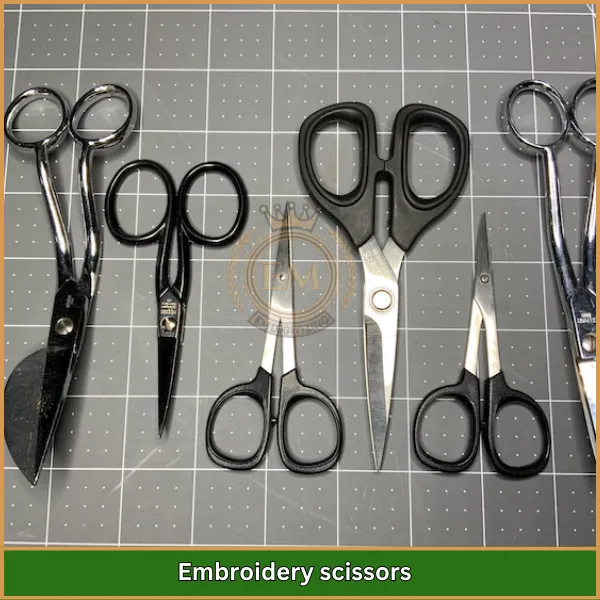
Forbici da ricamo: Questi sono piccoli e affilati, rendendoli perfetti per tagliare i fili in aree ristrette. Le loro punte appuntite aiutano a evitare tagli accidentali del tessuto.

Pinzette: Una volta tagliate le maglie, le pinzette sono utili per estrarre i fili sciolti e rimuovere eventuali pezzetti rimanenti.
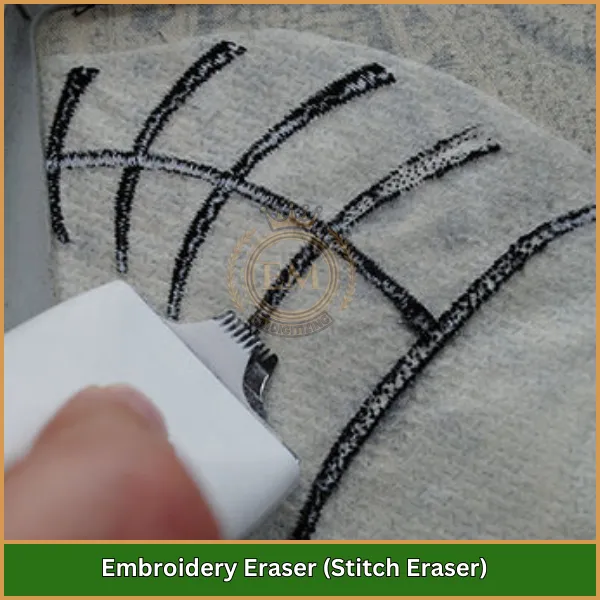
Gomma da ricamo (Gomma per punti): Questo strumento elettrico, simile ad un trimmer, è ottimo per rimuovere ricami più grandi in modo rapido ed efficiente.
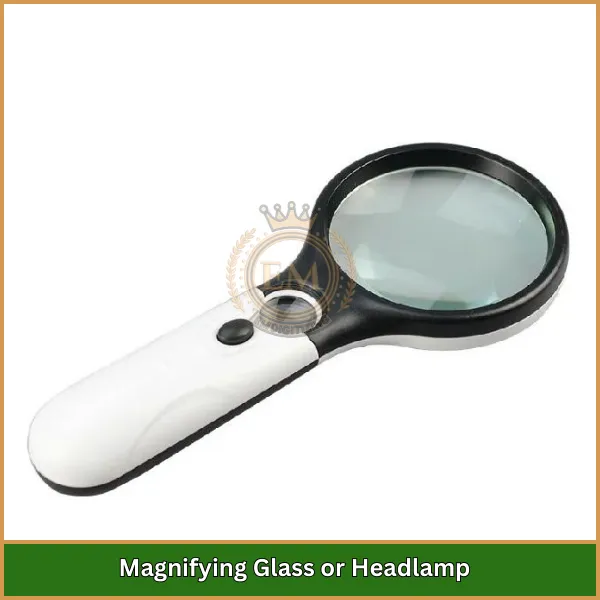
Lente d'ingrandimento o lampada frontale: If you’;stai lavorando su progetti dettagliati o piccoli, l'uso di una lente d'ingrandimento o di una lampada frontale ti aiuta a vedere chiaramente ogni punto.

Rullo o spazzola per lanugine: Dopo aver rimosso i punti, un rullo o una spazzola per lanugine ti aiuterà a pulire la peluria e i fili rimasti sul tessuto.
Questi strumenti rendono il rimozione del ricamo processo più semplice, e l'utilizzo di ogni strumento di rimozione garantisce che il tessuto rimanga intatto.
Come rimuovere il ricamo | I modi migliori
Rimuovere il ricamo può essere complicato, ma con i metodi giusti, diventa molto più facile. Ecco qui le 3 i modi migliori per rimuovere i ricami a macchina senza danneggiare il tessuto:
- Utilizzo di una gomma da ricamo
- Utilizzando un taglia asole
- Utilizzo delle forbici da ricamo
1. Utilizzo di una gomma da ricamo
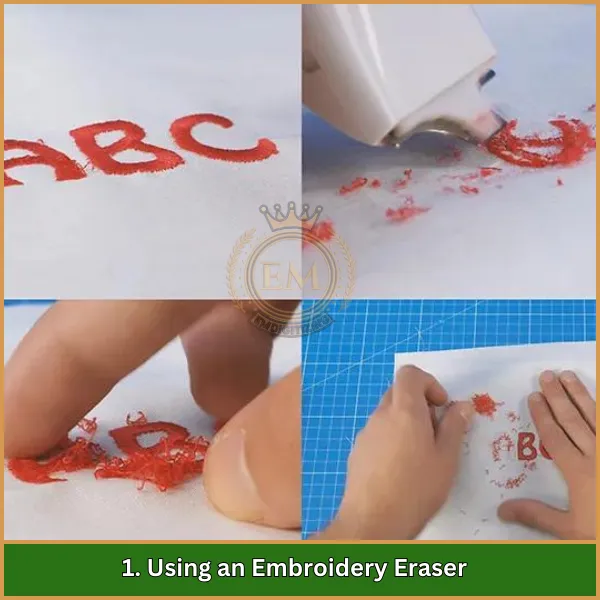
- Capovolgi il tessuto – Capovolgi il tessuto per accedere più facilmente ai punti.
- Posiziona il tessuto in un telaio – Fissare il tessuto con un telaio da ricamo per tenerlo stretto mentre tu rimuovere i punti.
- Accendi la gomma da ricamo – Passa delicatamente la gomma da ricamo sui punti, applicando una pressione sufficiente a tagliare i fili senza danneggiare il tessuto.
- Tirare i fili – Una volta tagliati i fili, girare il tessuto sul dritto e utilizzare una pinzetta per estrarre i fili sciolti.
- Pulisci il tessuto – Utilizzare un rullo o una spazzola per rimuovere eventuali fili o lanugine rimanenti dopo il processo.
2. Utilizzando un taglia asole

- Capovolgi il tessuto – Inizia rivoltando il tessuto per accedere e rimuovere facilmente i punti dal retro.
- Inserisci lo taglia asole sotto i punti – Fai scorrere il taglia asole sotto alcuni punti e sollevalo delicatamente per tagliarli.
- Tirare i fili – Rivoltare il tessuto sul davanti e utilizzare una pinzetta o le dita per estrarre i fili allentati.
- Ripeti il processo – Continua a tagliare e tirare i punti finché non viene rimosso l’intero disegno.
- Pulisci il tessuto – Utilizzare un rullo levapelucchi per rimuovere eventuali fili o lanugine rimanenti.
Questo metodo è il modo migliore per rimuovere i ricami in modo accurato ed efficace.
3. Utilizzo delle forbici da ricamo
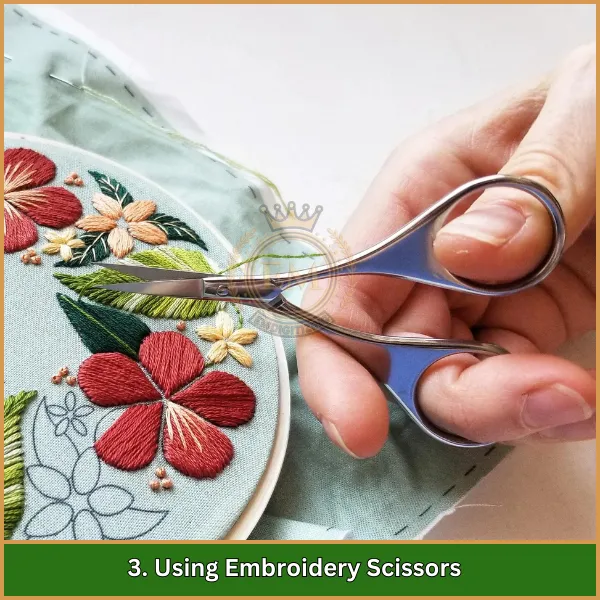
- Capovolgi il tessuto – Inizia girando il tessuto al rovescio in modo da poter vedere chiaramente i punti.
- Taglia con attenzione i punti – Usa la punta affilata del tuo forbici da ricamo tagliare con attenzione pochi punti alla volta senza danneggiare il tessuto.
- Estrarre i fili sciolti – Rivoltare il tessuto ed estrarre delicatamente i fili sciolti con una pinzetta o con le dita.
- Continua a tagliare e tirare – Continuare a tagliare e tirare i fili finché tutti i punti non sono stati rimossi.
- Pulisci l'area – After you’;finito, utilizzare un rullo levapelucchi per rimuovere eventuali fili o lanugine rimanenti.
Questo metodo è ottimo per lavori precisi, soprattutto nelle aree più piccole, mantenendo il tessuto al sicuro da eventuali danni.
Come rimuovere le toppe da ricamo ostinate?
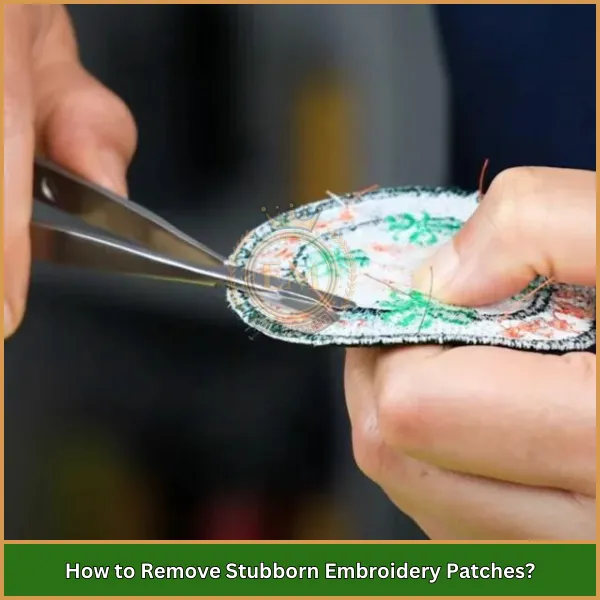
Rimuovere le patch può essere complicato, soprattutto quando sono cuciti o incollati saldamente sul tessuto. Ecco una semplice guida su come rimuovere toppa da ricamo senza danneggiare il tuo capo:
- Taglia i punti – Se la toppa è cucita, inizia rivoltando il tessuto. Usa un taglia asole o delle piccole forbici per tagliare con cura i punti dal dietro. Questo allenterà la patch.
- Staccare la toppa – Una volta tagliati i punti, staccare delicatamente la toppa dal tessuto. Se non si stacca facilmente, potrebbe esserci dell'adesivo che lo tiene in posizione.
- Usa il calore per le toppe adesive – Se la toppa è incollata, posizionarci sopra un panno e utilizzare un ferro caldo a temperatura bassa. Il calore ammorbidirà la colla, rendendo più facile staccare il cerotto.
4. Rimuovere eventuali residui di adesivo – Per residui di adesivo, puoi utilizzare un solvente adesivo sicuro per il tessuto, oppure strofinare la zona con un panno umido e sapone.
Seguire questi passaggi per rimuovere le toppe ti aiuterà a rimuovere la toppa senza danneggiare il tessuto.
Metodi per rimuovere disegni da ricamo più grandi
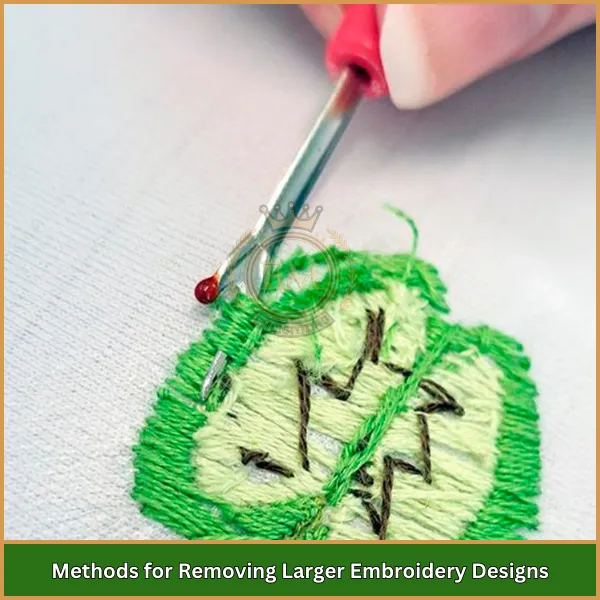
- Usa una gomma da ricamo – Una gomma da ricamo è uno strumento elettrico, simile ad un trimmer, progettato per rimuovere rapidamente ricami più grandi. Taglia efficacemente molti punti contemporaneamente, rendendolo ideale per disegni grandi o densi.
- Stabilizzare il tessuto con un telaio – Per disegni più grandi, fissare il tessuto in un telaio da ricamo lo mantiene stretto e rende il processo di rimozione più fluido. Ciò impedisce al tessuto di ammucchiarsi durante l'utilizzo di strumenti come la gomma o il taglia asole.
- Tagliato in sezioni – Quando si ha a che fare con aree di ricamo di grandi dimensioni, è utile dividere il disegno in sezioni. Ciò facilita la concentrazione su una parte alla volta e garantisce una rimozione più pulita.
- Usa le forbici per le aree strette – In punti dettagliati o ristretti all'interno del grande disegno, le forbici da ricamo possono aiutare a tagliare i fili con precisione.
Questi metodi sono efficaci per affrontare problemi più grandi disegni da ricamo, rendendo il processo più rapido e riducendo il rischio di danni al tessuto.
La rimozione del ricamo lascerà segni o buchi?
Quando rimuovi ricamo a macchina, potrebbe lasciare piccoli fori o segni sul tessuto. Ciò accade perché i fili creano piccoli fori nel materiale. Per tessuti più spessi come i jeans, questi buchi sono solitamente difficili da vedere. Ma per tessuti sottili come seta o cotone, i buchi potrebbero essere più evidenti.
Nei casi in cui la rimozione dei buchi diventa un problema, puoi ripararli ricamando sull'area o utilizzando tecniche di riparazione del tessuto. Se necessario, puoi chiedere aiuto professionale per creare design personalizzati in grado di coprire eventuali imperfezioni.
Errori comuni da evitare durante la rimozione del ricamo
Removing embroidery can be tricky if you’;non stai attento. Ecco alcuni errori comuni da evitare:
- Tirare troppo forte – Quando si tirano i fili con troppa forza, puoi strappare il tessuto. Sii sempre gentile e paziente.
- Usare gli strumenti sbagliati – It’;È importante utilizzare gli strumenti giusti, come un taglia asole o delle forbici da ricamo. Le forbici normali possono danneggiare il tessuto.
- Tagliare troppi punti contemporaneamente – Cercare di tagliare troppi punti contemporaneamente può portare a errori. It’;È meglio andare piano e tagliare pochi punti alla volta.
- Saltare la pulizia – Dopo aver rimosso i punti, assicurati di pulire eventuali fili rimanenti o peluria con un rullo per lanugine. Questo è uno dei consigli chiave per il ricamo per una finitura accurata.
Evitando questi errori, you’;manterrai il tuo tessuto al sicuro e renderai il processo molto più semplice.
Pensieri finali
All'inizio togliere i punti indesiderati può sembrare difficile, ma con gli strumenti giusti e passaggi attenti, puoi rimuovere in sicurezza il ricamo senza danneggiare il tessuto. Seguire le tecniche contenute in questa guida ti aiuterà a correggere eventuali errori con facilità.
Se stai lavorando a un progetto di ricamo e hai bisogno di disegni personalizzati, EMDigitalizzazione è qui per aiutarti! Offriamo veloce, affidabile servizi di digitalizzazione del ricamo.
I clienti alle prime armi possono divertirsi 50% disattivati tutti i servizi, e puoi anche ottenere un PREVENTIVO GRATUITO nel giusto 5 minuti.
Visita oggi stesso il nostro sito web per esplorare i nostri servizi e lasciaci aiutarti a rendere il tuo prossimo progetto di ricamo un successo!
Domande frequenti
Il modo più veloce è utilizzare un taglia asole elettrico, che taglia rapidamente i punti ma richiede precisione per evitare danni al tessuto.
Rimuovere con attenzione il supporto in eccesso, quindi utilizzare un caldo, panno umido per ammorbidire e rimuovere il rivestimento rimanente senza danneggiare il tessuto.
sì, l'utilizzo di un taglia asole affilato e il lavoro paziente rendono il processo più semplice senza danneggiare il tessuto.
Fai scorrere un taglia asole sotto ogni punto, tagliare il filo, e sollevarlo. Usa una pinzetta per rimuovere eventuali pezzetti rimanenti e taglia con piccole forbici.
Allenta delicatamente i punti difficili con un taglia asole o un ago, prenditi il tuo tempo per evitare danni. Una lente d'ingrandimento può aiutare con precisione.
